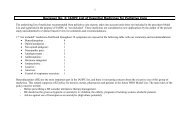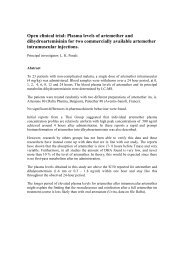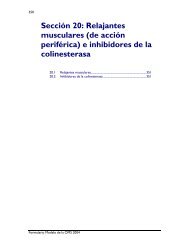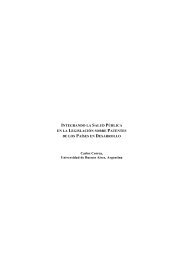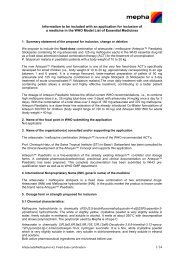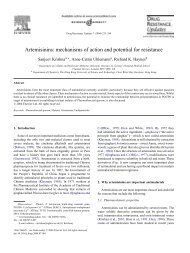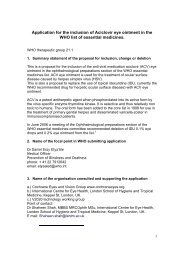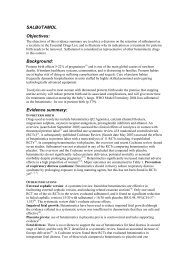SODIUM VALPROATE IN CHILDHOOD EPILEPSY
SODIUM VALPROATE IN CHILDHOOD EPILEPSY
SODIUM VALPROATE IN CHILDHOOD EPILEPSY
Create successful ePaper yourself
Turn your PDF publications into a flip-book with our unique Google optimized e-Paper software.
epilepsy do better on carbamazepine. For time to 12 month remission, results for the<br />
subgroup of people with a partial epilepsy indicate a significant advantage for<br />
carbamazepine, although the test for an interaction between treatment and epilepsy<br />
type was not significant.<br />
Sodium valproate has also been compared with some of the newer antiepeileptic<br />
drugs, notably lamotrigine and topiramate.<br />
Steinhoff BJ et al (15) conducted an open label 24 week monotherapy trial in 239 newly<br />
diagnosed epilepsy patients of 12 years and over. Patients with focal epilepsy were<br />
treated with lamotrigine or carbamazepine and those with generalized epilepsy<br />
received lamotrigine or sodium valproate. The primary efficiency variable was the<br />
number of seizure-free patients during study weeks 17 and 24. There were 63<br />
patients in the generalised epilepsy group of whom 30 received valproate. During<br />
study weeks 17 and 24, 61% of the lamotrigine patients and 84% of the valproate<br />
patients became seizure free. The drop out rate due to lack of efficacy or adverse<br />
effects was 12% with lamotrigine and 3% with valproate.<br />
Coppola G et al (16) also conducted a study comparing lamotrigine with valproic acid.<br />
This was a randomised, open-label parallel group design study of 38 children (3-13<br />
years) with newly diagnosed childhood or juvenile typical absence seizures. Patients<br />
received either lamotrigine (dose gradually increased until seizures controlled or<br />
maximum dose 12mg/kg/DAY) or valproic acid (dose gradually increased until<br />
seizures controlled or maximum dose 30mg/kg/DAY). After 1 month of treatment,<br />
10/19 children taking valproic acid and 1/19 taking lamotrigine were seizure free; by 3<br />
month follow-up 12/19 taking valproic acid and 7/19 taking lamotrigine were seizure<br />
free; at 12 months 13/19 taking valproic acid and 10/19 taking lamotrigine were<br />
seizure free. Side effects were mostly mild and transient and were recorded in 2<br />
children treated with valproic acid and in 6 treated with lamotrigine.<br />
Wheless JW et al (17) reported on a double blind randomised study in which<br />
topiramate, carbamzepine and valproate monotherapy demonstrated similar times to<br />
study exit, times to first seizure and proportions of patients who were seizure-free<br />
during the first 6 months of follow-up. Of the total 613 patients (119 of whom were<br />
children or adolescents), 46% completed the study. Adverse effects accounted for<br />
19% and 23% of discontinuations in the topiramate and traditional therapy arms<br />
respectively. Ineffective treatment accounted for 11% and 12% of discontinuations in<br />
the topiramate and traditional therapy arms. The time to exit and the time to first<br />
seizure did not differ. The proportion of patients who did not experience a seizure<br />
during the last 6 months of the study was 49% of the topiramate patients and 44%<br />
each of the carbamazepine and valproate patients.<br />
Sodium valproate is also sometimes used in the treatment of absence seizures and<br />
the Cochrane Collaboration in 2005 (18) , conducted a systematic review of the<br />
evidence for the effects of ethosuximide, valproate and lamotrigine as treatments for<br />
children and adolescents with absence seizures when compared with placebo or<br />
each other. Studies included were randomised parallel group monotherapy or add-on<br />
trials which included a comparison of any of the following in children or adolescents<br />
with absence seizures. Unfortunately however, of the 5 small trials found, 4 were of<br />
poor methodological quality and did not have a sufficient number of participants.<br />
Sodium valproate page 8



